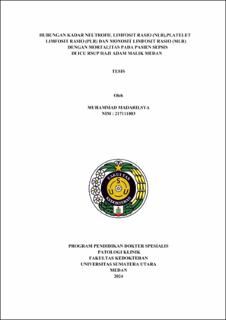Hubungan Kadar Neutrofil Limfosit Rasio (NLR), Platelet Limfosit Rasio (PLR) dan Monosit Limfosit Rasio (MLR) dengan Mortalitas pada Pasien Sepsis di ICU RSUP Haji Adam Malik Medan
Relationship of Neutrofil Lymphocyte Ratio (NLR), Platelet Lymphocyte Ratio (PLR) and Monocyte Lymphocyte Ratio (MLR) with Mortality in Sepsis Patients in ICU of Haji Adam Malik Hospital Medan

Date
2024Author
Madarilsya, Muhammad
Advisor(s)
Permatasari, Ranti
Lubis, Bastian
Metadata
Show full item recordAbstract
Objective:
To determine the relationship between the levels of Neutrophil Lymphocyte Ratio (NLR),
Monocyte Lymphocyte Ratio (MLR), and Platelet Lymphocyte Ratio (PLR) upon ICU
admission and the mortality rate of sepsis patients at RSUP Haji Adam Malik Medan.
Method:
This study is an analytic research with a retrospective design, observing the results of Neutrophil
Lymphocyte Ratio (NLR), Platelet Lymphocyte Ratio (PLR), and Monocyte Lymphocyte Ratio
(MLR) from the time of ICU admission to ICU discharge, with the aim of assessing the
mortality rate of sepsis patients. The data used was obtained from medical records, involving
48 patients diagnosed with sepsis from January 2023 to December 2023. The study applied
significance tests to compare the characteristics of two groups before and after treatment using
the Wilcoxon test, while clinical parameters between the two groups were compared using the
Mann-Whitney test.
Results:
In the deceased group, there were more female patients, with 19 patients (52.8%) compared to
17 male patients (47.2%). In the survival group, there were more male patients, with 7 patients
(58.3%) compared to 5 female patients (41.7%). In the deceased group, the average NLR at the
beginning of the study was 18.97 ± 16.28, and there was no significant increase by the end of
the study, with the average NLR value rising to 20.78 ± 17.20 (p = 0.300). In the survival group,
the average NLR at the beginning was 16.5 ± 18.17, and there was no significant increase by
the end of the study, with the average NLR value rising to 17.96 ± 14.08 (p = 0.480). In the
deceased group, the average PLR at the beginning of the study was 306.29 ± 239.07, and there
was no significant increase by the end of the study, with the average PLR value rising to 5404.39
± 21293.03 (p = 0.741). At the start of the study, the average MLR value in the deceased group
was higher compared to the survival group, but statistical testing showed no significant
difference in the average initial MLR values between the two groups
(p = 0.299).
Conclusion:
There were no significant differences between gender and age in both groups (p-value > 0.05).
Among the 48 patients studied, no significant relationship was found between the variables
examined NLR, PLR, and MLR and mortality in sepsis patients.
Collections
- Master Theses [162]
